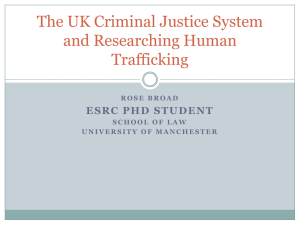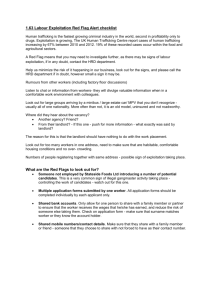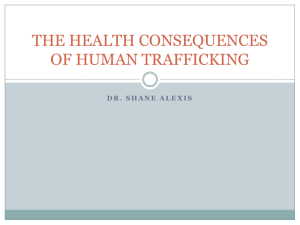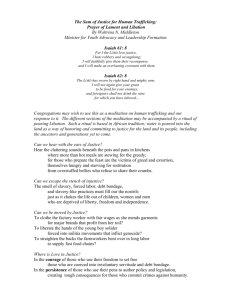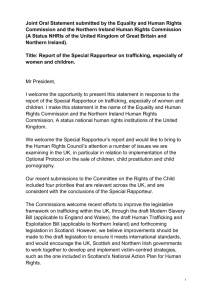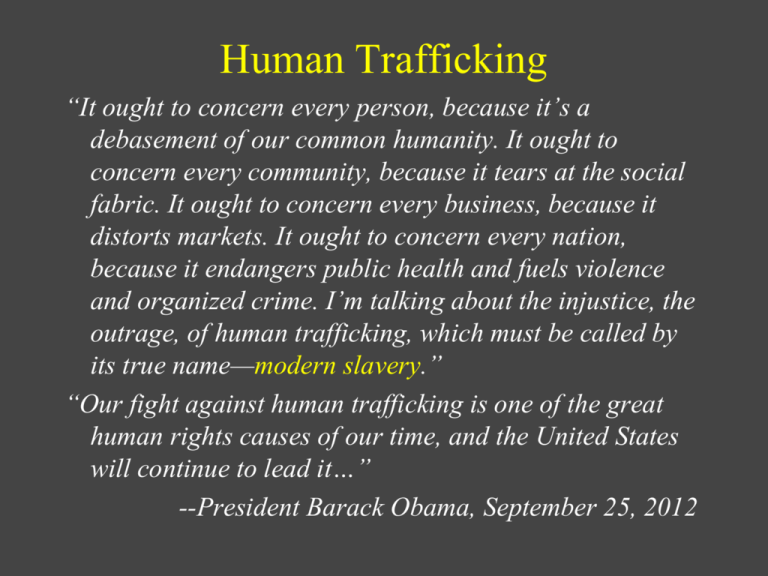
Human Trafficking
“It ought to concern every person, because it’s a
debasement of our common humanity. It ought to
concern every community, because it tears at the social
fabric. It ought to concern every business, because it
distorts markets. It ought to concern every nation,
because it endangers public health and fuels violence
and organized crime. I’m talking about the injustice, the
outrage, of human trafficking, which must be called by
its true name—modern slavery.”
“Our fight against human trafficking is one of the great
human rights causes of our time, and the United States
will continue to lead it…”
--President Barack Obama, September 25, 2012
Human Trafficking –
Identification in a Health Care
Setting
October 18, 2012
Role of the Health Care Setting in
Identifying and Helping
Victims of Human Trafficking
SF Department of Public Health
Learning Objectives
•What is human trafficking
•Identifying human trafficking victims
•Health & medical issues associated
with trafficking victims
•Communicating with trafficking
victims
•Role of health care provider
•Resources
What is Human Trafficking?
Prostitution
Child prostitute
Sexually Exploited Minor
Slavery
Modern-day slavery
Human smuggling
Human trafficking
Human Trafficking vs. Smuggling
• Smuggling: Individual
voluntarily crosses
international border for a fee
• Trafficking: Individual forced
or deceived into involuntary
service or labor even if
voluntarily crossed borders
• Domestic trafficking: U.S. American youth or adult
forced into commercial
sexual exploitation and / or
labor
Human Trafficking
OR
Action
+
Recruits
Harbors
Transports
Provides
Obtains
Means
Force
Fraud
Coercion
+
Purpose
Sex
Labor
Crime of trafficking occurs with the exploitation of the victim.
The physical movement of the victim is not a requisite.
The TVPA protects both U.S. citizens and non-citizens.
Human Trafficking Under Age 18
OR
Action
+
Recruits
Harbors
Transports
Provides
Obtains
Means
Force
Fraud
Coercion
+
Purpose
Sex
Labor
Forms of Human Trafficking
Sex Trafficking:
• Commercial sex
• Anyone under the 18 years of age in the sex industry
• Massage parlors, brothels, strip clubs, escort services,
internet
•
Labor Trafficking:
• Recruit, harbor, transport, obtain or employ a person for
labor or services in involuntary servitude, peonage, debt
bondage or slavery
• Nannies, maids, sweatshop factories, janitorial jobs,
construction sites, farm work, restaurants, hotels
Global Human Trafficking
Who is Trafficked?
Up to 30 Million people are exploited worldwide
for forced labor and sexual exploitation.
(United Nations, ILO, International Labor Organization, Not For Sale Campaign)
Each Year:
Approximately 800,000 to 900,000 victims are
trafficked across international borders. (DHHS)
Between 17,500 - 20,000 victims are trafficked
into the U.S. (ICE, DHHS)
Local Human Trafficking
Cases have been reported
in all 50 US states.
California is a major
trafficking entry point.
43% of California
trafficking incidences
occur in the Bay Area*.
*South Bay Coalition to End Human
Trafficking www.sbcteht.com
Labor and Sex Trafficking
in the Bay Area
• Sex work (commercial and
• Criminal activity
non-commercial)
•
•
•
•
•
•
•
•
Domestic service
Nannies
Marriage
Factories
Agriculture
Restaurant work
Manufacturing work
Home/Residential
care facilities
(including drug trafficking)
•
•
•
•
•
•
Construction
Hotel/motel
Housekeeping
Daycare teacher
Cleaning business
Candy/trinket sales
Who are the Traffickers?
• 42% are women *
• 46% of cases the recruiter was known
to the victim*
*International Organization for Migration 1999.
Mabelle de la Rosa Dann
Walnut Creek
Home of Giuseppe & Kesia Penzato
San Francisco
Lakireddy Bali Reddy
Berkeley
Victim Profile
• Isolated (physically and linguistically)
• Lack Information
• Intimidated, Monitored
• Physically Threatened and Abused
• Emotionally Manipulated
• Vulnerable populations
What are the Signs?
• Being Controlled
• Lack of knowledge of the local
community
• Health Issues
• Work Conditions
Frontline health providers play
an important role in identifying and
helping trafficking victims
Health Risk Factors
•
•
•
•
•
•
Inhumane living conditions
Dangerous workplace conditions
Poor sanitation & personal hygiene
Physical and emotional abuse
Inadequate nutrition
Lack of quality medical care
Health Issues Associated with
Victims of Human Trafficking
• STDs, botched or unsafe abortions
• Infections or mutilations caused by “home”
medical procedures
• Chronic back, hearing, cardiovascular or
respiratory problems
• Weak eyes and other eye problems
• Malnourishment and serious dental problems
Health Issues Associated with
Victims of Human Trafficking
• Infectious diseases like tuberculosis
• Undetected or untreated diseases, such as
diabetes or cancer
• Bruises, scars, “branding” and other signs
of physical abuse and torture
• Substance abuse problems or addictions
• Psychological trauma
Video
Child Sex Trafficking
• Many terms used to define the problem
– Child/adolescent prostitution
– Child sex trafficking
• Commercial sexual exploitation of children
(CSEC) = commercial sexual exploitation in
which the exploited individual is a minor <18yo,
and includes survival sex.
CSEC includes:
Commercial
– Street prostitution
– Pornography
– Stripping
– Erotic/nude massage
– Escort Services
– Phone sex lines
– Private parties
– Gang-based prostitution
– Interfamilial pimping
– Forms of Internet-based exploitation
SURVIVAL SEX
Epidemiology
• Global—1.2 million children are trafficked
worldwide year (UNICEF)
• US- estimated 300,000 children are at risk for
commercial sexual exploitation (US DOJ)
– Estimated 200,000 incidents of sexual
exploitation of minors occur each year in the
US (Shared Hope International)
Epidemiology
• Multiple studies estimate that 70-90% of
sexually exploited youth have a history of
sexual abuse
Cycles of Violence and Child
Trafficking
Pathways to CSEC
Pathways to Entry
•
•
•
•
•
Parents selling children
Violence or forced by family
Kidnapping
Seduction/coercion
False advertising for “modeling” “acting”
and “dancing”
• Peer recruitment
• Internet enticement through chat
rooms/profile sharing
Recruiters (pimps)
• Come from families, “friends” others in group
homes, criminal networks (gangs, drug dealers)
• Online from social networking
Recruiters pattern of behaviors
•
•
•
•
Manipulation
Create and illusion of family structure
Becomes role model/parent figure
Different types
– Boyfriend
– Business man
– Guerilla (severe abuse usually associated w/ this type)
Red Flags for CSEC
• Truancy of stops going to school
• Sudden changes in appearance (nails, hair,
clothing)
• Has access to cash (taking friends shopping, out
to eat)
• h/o arrest for drug possession or sale, theft,
possession of weapons, or prostitution
• Older boyfriend
Red Flags for CSEC
• Mental Health Symptoms
– Severe PTSD, anxiety, other traumatic sxs e.g.
disassociation
• AWOL from group homes
• h/o sexual abuse and/or DV
• Early sexual initiation and/or knowing a great
deal about sex
• Acting more mature than age
Symptoms of CSEC
• New definition of self/self worth
• Emotional attachments to perpetrators, desire to
protect perps
• Addicted to the “life” and often takes several
times to leave (estimates are average of 6 times)
• Ego boosts from tricks/customers
• Relates to all men in a sexual way and as
potential tricks.
Stockholm Syndrome/Trauma
Bonds
• Criteria for Stockholm Syndrome
– The presence of a perceived threat to one’s
physical or psychological survival and the
belief that the abuser would carry out the
threat.
– The presence of a perceived small kindness
from the abuser to the victim
– Isolation for perspectives other than those of
the abuser
– The perceived inability to escape the situation
Stockholm Syndrome/Trauma
Bonds
• How is it displayed
– Positive feeling by the victim towards the
abuser
– Negative feelings by the victim toward family,
friends, or authorities trying to help/rescue the
victim
– Support of the abuser’s reasons and behaviors
– Positive feelings by the abuser toward the
– Supportive behaviors by the victim at time
HELPING the abuser
Health Implications
• High rates exposure to STI’s and acquisition to
STI’s including Hep C and HIV
• High rates abnl PAP
• High rates UTI
• Pregnancy/infertility
• Physical injuries of abuse (fractures, lacerations,
head trauma, organ trauma etc)
• Homicide
Behavior/ Substance Abuse
Implications
• Severe Depression
• De-sensitized to violence
• Self-sabotage drops out of programs helping and
returns to pimp
• Lack of trust in adults
• High levels of shame
• High levels of substance use esp. addictive drugs
(can switch from exchanging sex for money to sex
for drugs)
How CSEC interfaces w/ health care
providers
• Will use cases to demonstrate:
–
–
–
–
–
–
Type of visits for medical care/evaluation
Disclosure how it occurs
Issues/Successes
Common Themes
Signs and symptoms
Areas for prevention/intervention
Different Venues for Health Care
Provider Interactions
• Can occur in ANY HEALTH CARE
SETTING!
• 3 COMMON settings
– Urgent Care/ED and Family Planning
– Primary Care
– Sexual Assault Examiner
Populations at “RISK”
• The “underserved” populations
–
–
–
–
–
–
–
Foster care youth
Institutionalized youth
Incarcerated youth
Immigrant youth
Homeless/runway youth
GLBT Youth
Disabled, developmental delay
ED/Urgent Care/Reproductive Health
Provider
• CSEC often will come in to address acute
medical or reproductive health needs
• Trafficker will want victim to be medically
treated in urgent/quick manner
• many commercial sex workers including <18yo
need FP services
Urgent/ED Reproductive Care
Case 19 you woman presenting for 1st visit for STI
evaluation.
• Discloses on intake form she works as an “escort”
• Admitted to sex work since 16yo after her mother died
and didn’t want to live w/ father who was an alcoholic
• Dx’d w/ HSV and later Chlamydia
• h/o alcoholism (how she “coped” w/ being an escort)
• h/o Family DV
Urgent/ED/Reproductive Care
Issues
– Fear of leaving sex work due to sex trafficker (pimp)
– Missed opportunities (? CPS involvement/school
involvement) when victims first enter into sex work
– STI’s difficult to f/u and treat (esp. partners) and high risk
for HIV and other STI’s
– Lack of protocols in how to help these patients
particularly in leaving sex work in this setting.
– Lack of primary care knowledge and ability to refer to
primary care counseling (e.g. therapy and alcohol abuse)
Urgent /ED/Reproductive Care
Success
– Sexual History/forms can facilitate disclosure
• “how many partner have you had sex with in the last year?”
• “have you ever exchanged sex for money, drugs, housing,
or food”
– STI counseling and contraception discussed.
– Drug and Alcohol treatment counseling resources
given.
– Confidentiality maintained (pt was trusting of clinical
setting and followed up for future care)
PCP
Case 16yo female for routine health evaluation
• 16 y.o. first time seeing a PCP in >4 years.
• Was in drug treatment program for methamphetamines,
alcohol
• Disclosed >100 sexual partners
• Sex trafficking since 11yo
• +h/o STI’s
• +h/o child pornography
• +h/o various living situations
• +h/o family DV
• Currently in foster care
PCP
Issues in providing care:
• Lack of protocols for the health care provider in
caring for CSEC
• Difficulty in gaining the trust in order to establish
care for CSEC for both providers/and their clinical
settings.
• Barriers in disclosure due to reporting laws (pt
aware of mandating reporting so didn’t disclose)
– Communication w/ many agencies and coordinating care
(foster care, drug treatment, therapists) especially for
survivors of CSEC
PCP
Success in providing care:
– Providers awareness of CSEC, (esp. the significant
barriers around a pt’s willingness to consider exiting
the life of CSEC), and how to help victims begin to
trust adults in their lives.
– Supportive foster care environment that is aware and
understands CSEC.
– Availability of community agency focused on
working w/ CSEC
Sexual Assault Examiner
• Referrals come from working with
multidisciplinary agencies
–
–
–
–
–
CPS
Investigators with sex crimes
Immigration
DA’s
Advocates
• Both known vs.. unknown cases referred that
may involve sexually exploited youth
Sexual Assault Examiner
Case: 12 y.o. female referred for sexual assault exam
• Mother undocumented/ pt legally born
• Living in a room rented in a house
• Disclosure of sexual assault by pt to teacher
• Later full disclosure of housing arrangement with
mother allowing landlord to have sex with her
daughter in place of rent.
• h/o domestic violence
• h/o physical abuse by biological father
Sexual Assault Examiner
Issues
• Missed opportunities (pt had many prior CPS
reports)
• Immigration perceived barriers (pt fearful of
disclosure due to mother’s immigration status)
• Missed signs/symptoms (e.g. PTSD symptoms
of pt who was in counseling but never disclosed
sexual abuse and being exploited)
• Developmental age issues (early maturing
adolescents)
Sexual Assault Examiner
Success
• School was aware of behavioral/emotional
issues and gained initial disclosure
• Sexual Assault Center aware of sexual
exploitation and inquired.
• Sexual Assault Center understand and
closely collaborates w/ agencies involved in
sexually exploited youth (CPS, DA’s etc)
Labor Trafficking
Domestic Labor Trafficking
• Involuntary labor obtained through force, fraud,
debt bondage, or coercion
• Purpose for labor or services
• Can overlap with sexual exploitation
Labor Trafficking
• More international involvement of labor
trafficking vs. sex trafficking
• Often comes to US from Latin countries and
East Asia but many other countries involved
• Illegal status of victim is often used as means
towards coercion for enslaving
Labor Trafficking
•
•
•
•
Victims are often isolated
Frequent moves
Language barriers
Difficulty indentifying who the victims are
(hidden b/c of lack of papers, contact info, etc)
Labor Trafficking Health Implications
•
•
•
•
Malnutrition
Sleep deprivation
Effects of physical abuse
Effects of prolonged labor (arthritis, back
injuries, etc)
• Exposure to toxins
• Psychological trauma
Communicating with Victims
of Human Trafficking
• Do no harm - ensure safety
• Strict confidentiality
• Don’t assume the person with the potential victim
is someone you can trust
• Enlist trusted translator/interpreter who also
understands victim’s cultural needs
• Importance of indirect and sensitive questions
Questions to Ask...
•
•
•
•
•
•
•
•
What are your working or living conditions like?
Where do you sleep and eat?
Can you leave your work or job situation if you want?
When you are not working, can you come and go as you
please?
Have you been threatened with harm if you try to
quit?
Has anyone threatened your family?
Do you have to ask permission to eat, sleep or go to
the bathroom?
Is there a lock on your door or windows so you cannot get
out?
Know Your Resource & Referral Information!
Role of Health Care Provider
• Often the few people trafficking victims have
contact with.
• Recognize signs (physical abuse), symptoms
(anxiety), particularly in immigrant populations
• Interview pts alone
• Interview pts in w/ medical interpreters
• Ask about hours of work, who they work for,
feelings of safety
• Consider CPS involvement if <18yo
• Know resources
Role of health provider
• Recognize signs/symptoms
• Provide non-judgmental approach to care
• Know agencies and community organizations
involved in the lives of victims and collaborate
with them in treating and supporting these young
people
• Begin to establish policies and protocols to
screen, identify, and provide care for victims
w/in your practice and communities.
SFPD – Special Victims Unit
Victims of Trafficking & Their Needs
Immediate assistance
• Medical, housing, food, safety and
security, language interpretation
and legal services
Mental health assistance
• Counseling
Government benefits
• Medicaid, cash assistance, food
stamps, WIC, TANF
Immigration relief
• Attorneys and support, immigration
certification, T-visas
Resources & Assistance for Victims
In SAN FRANCISCO:
• The SAGE Project, Standing Against Global Exploitation
24-hour hotline: 877- 336-SAGE
SAGE will help you assess the situation, and come meet the person
if safe and possible. Comprehensive case management & therapy
• Newcomers Health Program 415-206-8608
Newcomers will help connect patient to services and continued
health care. In-person or phone interpreting
• SFPD SVU- Human Trafficking Investigator:
• Sgt. Tony Flores 415-999-4413
• Anonymous Hotline Number 415-643-6233
• National Human Trafficking Resource Center, 1-888-3737-888
• General information, policies, assessment cards, brochures, posters
Together We Weave
A Safety Net
QUESTIONS?
Thank you
You may be the only person a
victim of trafficking has contact with to link to
resources and services.
For any questions please contact:
SFDPH- Newcomers Health Program
Cristy Dieterich cristy.dieterich@sfdph.org
Samira Causevic samira.causevic@sfdph.org
Tonya Chaffee, MD, MPH chaffeet@peds.ucsf.edu 6M


